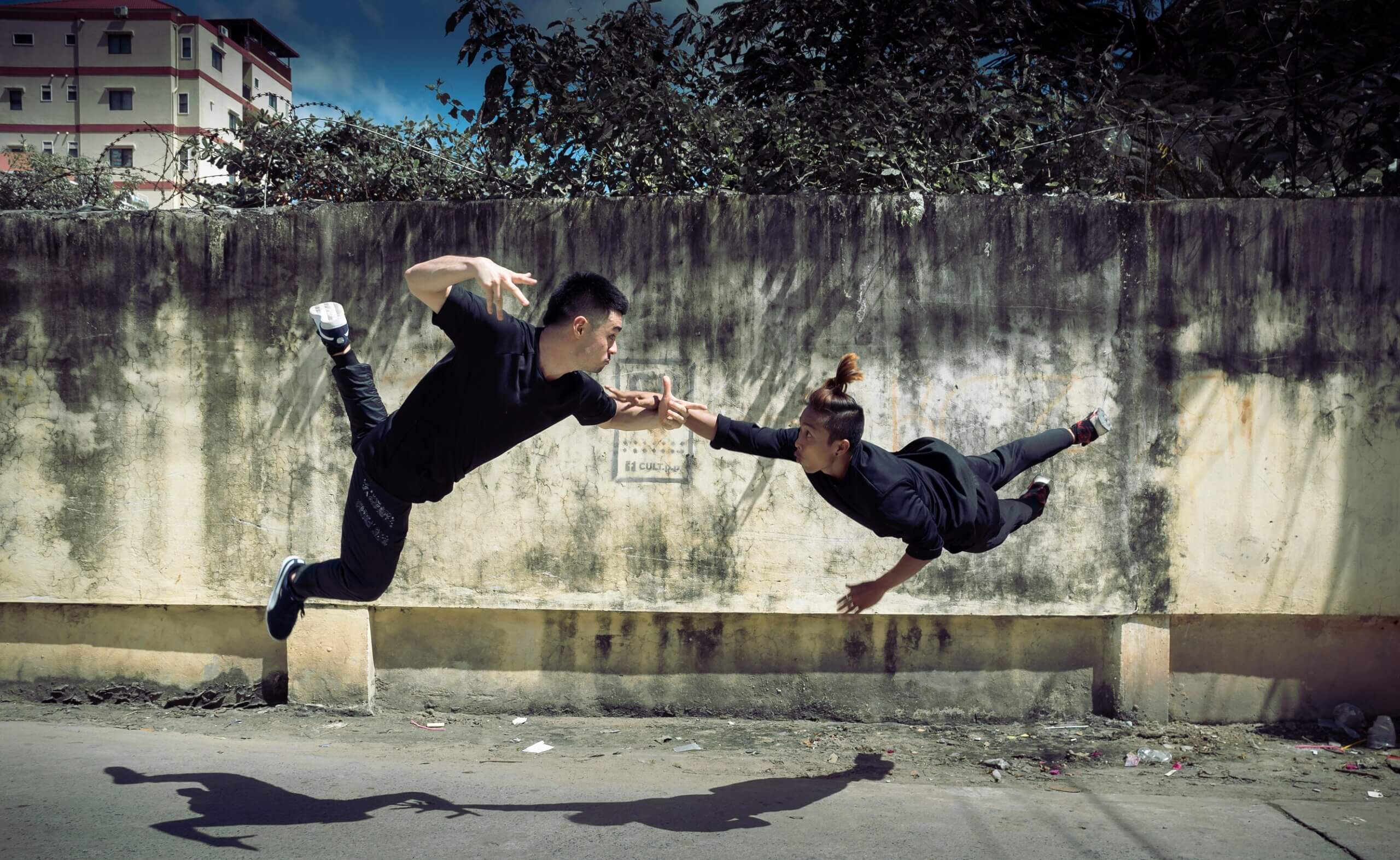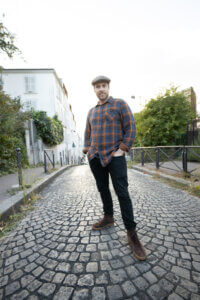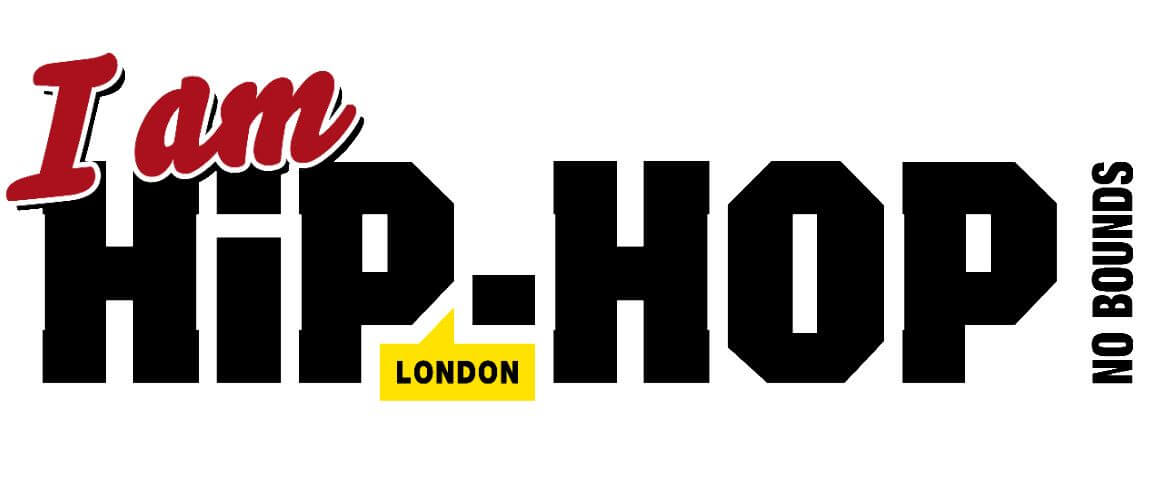
Between Tiny Cities by Thoeun Veassna
Internationally renowned Australian choreographer and b‑boy Nick Power presents Between Tiny Cities in the Lilian Baylis Studio at Breakin’ Convention this year. Dancers Aaron Lim and Erak Mith perform the duet in the round, blending the raw, wild energy of b‑boy battles with skilful improvisation and choreography, offering a cross-cultural perspective on style, culture and locality. Between Tiny Cities is performed as part of a UK tour and below, Nick Power tells us more about his hip hop trajectory and this dynamic work:
Nick, tell us about your own hip hop dance journey, when did it begin and how?
I started breaking in the early 90’s in my hometown of Toowoomba, renting video tapes like Beat Street, learning the moves by watching them in slow mo and then testing my mettle at the school socials or local underage discos. I soon found that hip hop gave me other avenues to connect with communities and broaden my skills, I started a late night hardcore hip hop radio show through the University channel and was very active as a graff artist. I felt I was doing something creative and important, contributing to the culture and the community.
When the time was right, I moved to the major capital of Brisbane and started training with high level b*boys. From there things started to gain momentum, I started my own crew, we would rock shows in clubs and festivals as well as battle at jams across the country. I also began to run hip hop workshop projects and throw events, this created a new trajectory for me and enabled me to work full time as a b*boy.
How did you meet and begin working with dancers Erak Mith from Phnom Penh and Aaron Lim? Can you describe their backgrounds and dance styles?
I was approached by Creative Producer Britt Guy who was interested in long term cross cultural projects and thought my style of working might suit a project she had in mind. She had done a residency at Tiny Toones — a hip hop organisation in Cambodia and was looking for a dance crew in Darwin to begin a collaboration. I had been working with Aaron and his crew D‑City Rockers for several years and I thought they would be a good fit for the project. Britt then arranged for Tiny Toones to come to Darwin Festival. The two crews spent two weeks jamming, performing and skill sharing, it was a really fun time and a strong connection and friendship was built. It all culminated with this crazy jam at Darwin Festival called Block Party at the Lighthouse, we performed a little showcase, battled and generally rocked the house, solidifying the connection
Can you explain how Between Tiny Cities evolved as a concept and its trajectory?
After that initial time in Darwin, D‑City travelled to Phnom Penh and got to see where Tiny Toones were coming from. It was a real eye opener, the organisation works with young people who don’t have access to education and it is set in one of the city’s most impoverished neighbourhoods. You could really see and feel what a positive and vital force hip hop was in the lives of the Tiny Toones students and Teachers. We were welcomed into the Tiny Toones studio by each student rocking a breaking set for us, it was this beautiful, cultural moment of connection through hip hop. During our stay in Phnom Penh I ran some choreographic sessions with the senior Tiny Toones Dancers and the D‑City Rockers, this time it was more exploratory and experimental and it was clear that both Aaron and Erak had a strong connection and were interested in pursuing this style of creation. After I got back to Australia it was really clear in my mind that the next step for the project would be to create a duet with these two dancers.
Duets can make compelling viewing, can you describe what audiences can expect?
Hip Hop has always been rooted in place, MC’s let you know where they’re from when they’re rocking the Mic, similarly, the way b*boys dance reflects their background. You can feel Phnom Penh when Erak dances, he fuses traditional Khmer styles into his b*boy language, he is from the streets of Phnom Penh you can see this in his character as he performs. Aaron’s style is also reflective of his background as a martial artist and his time teaching workshops in remote aboriginal communities. I call them the “Wild Styler” and “The Technician”. Erak, being the wild styler, is a very instinctive dancer, he doesn’t know what he is going to do and when he finishes his freestyle he usually doesn’t know what he has just done. This produces incredible moments of dance magic … but on the flipside it is a bit of a nightmare to choreograph. Aaron, on the other hand, is a very disciplined dancer, he has his sets and styles he can access and reproduce, he is super clean and highly technical. This difference is one of the works great strengths, their individual style and character really shine through and their different approaches to dance pushed us to find unorthodox and creative ways to structure and choreograph the work.

Nick Power is by Timothee Lejolivet
While this sense of place and individuality is clear and present in the work at its core it is about their friendship, brotherhood and all the fun, playful drama and levels of connection that is entwined within this relationship.
How have people responded on your travels? Do you think it’s increased awareness of hip hop in Australia and diversity there?
We have been blown away by the response to this work, it has gone out into the world in a way that we didn’t dream of. I think one of the reasons it has had such a big life is that it represents the relationship between Australia and Cambodia and more broadly South East Asia and it does this through the prism and common ground of hip hop. Australia generally looks to its more traditional ties to England and Europe, but our region, our geographical place in the world is part of Asia and the Pacific. To see this relationship played out between two dope b*boys I think it rings true and intrigues people on many levels.
What are you looking forward most to about performing at Breakin’ Convention?
We are so proud to be part of Breakin’ Convention, I have been once as a punter and absolutely loved it. The dopest thing is we get to share this work with our hip hop peers, that’s super exciting … and a bit scary. I’m also really looking forward to seeing the other performances, we don’t get a lot of hip hop theatre down under so it’s always inspiring to see what other artists are doing.
Breakin’ Convention is at Sadler’s Wells from Friday 29 April to Sunday 1 May. For more information go to www.breakinconvention.com
Rishma
Latest posts by Rishma (see all)
- INTERVIEW | TRELL SAVONE: FROM BUNKIE TO THE WORLD WITH “SHINE” — June 30, 2025
- NEW MUSIC | MCSOLOMON AND DERAJAH ‘KINGSTON TO LONDON’ — June 30, 2025
- REDMAN RETURNS TO THE UK THIS SUMMER FOR HIS LONG AWAITED TOUR — June 26, 2025
